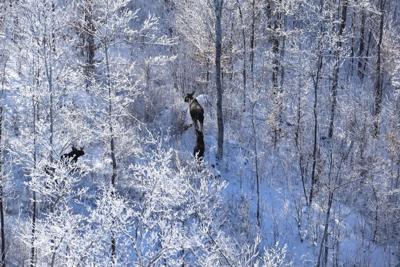ALBANY — The New York State Department of Environmental Conservation is in its second year of studying moose in the Adirondacks, fitting 19 moose with GPS collars as part of a project assessing health and population.
DEC is partnering with researchers at the New York Cooperative Fish and Wildlife Research Unit and the College of Veterinary Medicine at Cornell University, the State University of New York College of Environmental Science and Forestry (SUNY ESF) and Native Range Capture Services to capture, collar and collect biometric data on the moose.
The GPS collars will provide location data and information on moose activity patterns, movements and mortality. Data collected as part of this research effort will contribute directly to the continued management of moose in New York.
Previous moose research in the Adirondacks has helped researchers better understand adult moose survival and reproduction, but little is known about calf survival and dispersal in New York. By collaring calves and monitoring their survival to adulthood, biologists will be able to investigate factors limiting moose population growth, such as the effects of parasites on juvenile moose survival.
These parasites, including winter ticks, brain worm and giant liver fluke, and their associated diseases, have increasingly become a management concern in the Northeast and other northern regions in the United States where moose range.
“There are multiple stressors in New York that might be limiting moose population growth,” said Angela Fuller, a Cornell professor and U.S. Geological Survey New York Cooperative Fish and Wildlife Research Unit Leader. “Our research team includes wildlife and disease ecologists and wildlife managers, working closely to better understand the role that parasites might be playing in limiting moose populations.”
She added that the recent moose collaring effort will allow the team to estimate calf survival and better understand moose health.
Krysten Schuler, Wildlife Disease ecologist and director of the Cornell Wildlife Health Lab, said, “Unfortunately, we are seeing more evidence of parasites, like winter ticks and liver flukes, on the young moose, but this study allows us to identify management options for these problems.”
The cooperative research project is funded by a Federal Aid in Wildlife Restoration grant through the U.S. Fish and Wildlife Service. The funds are collected through federal excise taxes on firearms, ammunition and archery equipment and then apportioned to states for wildlife conservation.
This year’s research also includes sampling white-tailed deer pellets and water sources to detect and better understand the prevalence and distribution of brain worm and giant liver fluke across the landscape. Larvae from these parasites are found in deer scat, where they are picked up by snails and then incidentally consumed by moose as they forage on plants.
Trail cameras were deployed in the fall of 2021 to determine range overlap between deer and moose and to monitor hair loss on moose infested with winter ticks.





